|
|
|
Sort Order |
|
|
|
Items / Page
|
|
|
|
|
|
|
| Srl | Item |
| 1 |
ID:
188943
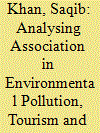

|
|
|
|
|
| Summary/Abstract |
Clean and green environment along with sustainable development is the prime objective of every state. We explore empirically the nexus between tourism, environmental pollution measured by carbon (CO2) emissions, population, trade, foreign direct investment (FDI) and economic growth in six countries from the Commonwealth of Independent States over 1995–2018. Traditional panel estimation technique is employed, where the Hausman test suggests fixed-effects over random effect estimator. We also employed the robust least squares (RLS) estimator to confirm the empirical estimates. Results show that a 1% increase in CO2 will attenuate the economic growth by 0.14% and that 1% raise in the tourism activities can boost growth by 0.04%. Both the fixed-effect and RLS estimates reveal that tourism, population growth and trade contribute significantly to economic growth, whereas CO2 adversely affect growth. The Granger causality test shows a two-way causality between economic growth and CO2 and between growth and trade. Empirical results also indicate a one-way causality between growth and FDI, population and FDI, population and CO2 along with population growth and tourism. These findings suggest that adopting effective policies that can expand trade, enhance FDI and promote the tourism sector with minimum environmental damage will ultimately accelerate sustainable economic development.
|
|
|
|
|
|
|
|
|
|
|
|
|
|
|
|
| 2 |
ID:
150781
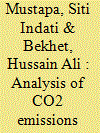

|
|
|
|
|
| Summary/Abstract |
The demand for transport services is expected to rise, causing the CO2 emissions level to increase as well. In Malaysia, the transportation sector accounts for 28% of total CO2 emissions, of which 85% comes from road transport. By 2020, Malaysia is targeting a reduction in CO2 emissions intensity by up to 40% and in this effort the role of road transport is paramount. This paper attempts to investigate effective policy options that can assist Malaysia in reducing the CO2 emissions level. An Optimisation model is developed to estimate the potential CO2 emissions mitigation strategies for road transport by minimising the CO2 emissions under the constraint of fuel cost and demand travel. Several mitigation strategies have been applied to analyse the effect of CO2 emissions reduction potential. The results demonstrate that removal of fuel price subsidies can result in reductions of up to 652 ktonnes of fuel consumption and CO2 emissions can be decreased by 6.55%, which would enable Malaysia to hit its target by 2020. CO2 emissions can be reduced significantly, up to 20%, by employing a combination of mitigation policies in Malaysia. This suggests that appropriate mitigation policies can assist the country in its quest to achieve the CO2 emissions reduction target.
|
|
|
|
|
|
|
|
|
|
|
|
|
|
|
|
| 3 |
ID:
098559
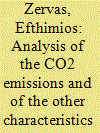

|
|
|
|
|
| Summary/Abstract |
This article analyzes the engine and vehicle characteristics and the CO2 emissions of the new passenger cars for all segments of the European market. As in the first article of this work, the target is to find the real market parameters influencing exhaust CO2 emissions. The present analysis is focused on the segment sales distribution (EU average and within each country) and also in four parameters of each segment influencing CO2 emissions: average vehicle weight, average engine capacity, average maximum and specific power. The second part of this work concerns the CO2 emissions of each segment on the New European Driving Cycle and its urban and extra urban parts.
|
|
|
|
|
|
|
|
|
|
|
|
|
|
|
|
| 4 |
ID:
162308


|
|
|
|
|
| Summary/Abstract |
In China, a large private sector has evolved alongside a still sizeable state-owned sector that is subject to government control. Several studies have found that in this mixed economy, the private sector is economically more efficient than the state-owned sector. In this paper, we investigate whether private firms are also more carbon efficient than state-owned firms. Using a macroeconomic panel data model with provincial data from 1992 to 2010, we confirm that private firms emit less carbon dioxide than state-owned firms. Our results imply that future reforms, such as ongoing privatization, introduced to increase the economic efficiency of state-owned companies will also mitigate emissions growth. The policy lesson, not only for China but for developing countries maintaining a large state-owned sector, is that economic efficiency and energy efficiency are conjoined mutual benefits.
|
|
|
|
|
|
|
|
|
|
|
|
|
|
|
|
| 5 |
ID:
162327
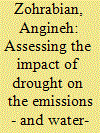

|
|
|
|
|
| Summary/Abstract |
This study investigates how technological transitions across California's power sector have shifted its state-level carbon dioxide emissions and cooling water consumption intensities. Its ultimate goal is to evaluate how the state's climate mitigation and environmental policies have affected the power sector's vulnerability to extreme drought and how extreme drought has affected progress towards the state's climate mitigation priorities. The study analyzes the period spanning 2010–2016, which includes one of the state's most severe droughts on record. The results indicate that the growth of variable renewable energy generation has helped offset some of the negative consequences of drought, which include increased emissions and cooling water usage by natural gas generators during periods of low hydropower. However, the retirement of the San Onofre nuclear power plant has delayed the overall decarbonization of the state's power sector, and the closure of significant coastal power plant capacity could increase the freshwater consumption of the power sector if replacement capacity is not cooled with alternative cooling water sources or dry cooling systems. The noted tradeoffs between greenhouse gas mitigation priorities, freshwater dependency, and vulnerability to climatic events highlight the importance of holistic decision making as regional power grids transition to cleaner generation sources.
|
|
|
|
|
|
|
|
|
|
|
|
|
|
|
|
| 6 |
ID:
093537
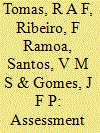

|
|
|
|
|
| Publication |
2010.
|
| Summary/Abstract |
This paper describes an assessment of the impact of the enforcement of the European carbon dioxide (CO2) emissions trading scheme on the Portuguese chemical industry, based on cost structure, CO2 emissions, electricity consumption and allocated allowances data from a survey to four Portuguese representative units of the chemical industry sector, and considering scenarios that allow the estimation of increases on both direct and indirect production costs. These estimated cost increases were also compared with similar data from other European Industries, found in the references and with conclusions from simulation studies. Thus, it was possible to ascertain the impact of buying extra CO2 emission permits, which could be considered as limited. It was also found that this impact is somewhat lower than the impacts for other industrial sectors.
|
|
|
|
|
|
|
|
|
|
|
|
|
|
|
|
| 7 |
ID:
093477
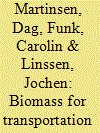

|
|
|
|
|
| Publication |
2010.
|
| Summary/Abstract |
The introduction of biofuels from biomass for transport purposes in an energy system model shows that bioethanol and vegetable oil can compete with oil products without subsidies provided prices of imported energy carriers are high, i.e. crude oil prices around $ 100/bbl. About half of the biomass will be used for motor fuel substitutes, whose share of the final energy in the transportation sector will increase to 10% in 2030. This gives rise to a nearly 9% drop in CO2 emissions in the transportation sector as compared to an emission balance where all real local emissions are fully counted. Despite a strong enhancement of biomass and biomass fuels and quite high prices for oil and gas up to 2030, BtL products like synthetic gasoline and diesel from biomass do not play an important part in the model results unless fairly high penalties are set for CO2 emissions. In the case of global CO2 penalties below Euro 300/tco2 the use of biomass will even shift away from vehicle fuel production to biomass power plants and CHP. A CO2 penalty above Euro 100/tco2 in the transportation sector only, will, however, trigger the production of liquids and synthesis gases from biomass for use as BtL.
|
|
|
|
|
|
|
|
|
|
|
|
|
|
|
|
| 8 |
ID:
088032
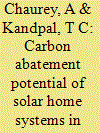

|
|
|
|
|
| Publication |
2009.
|
| Summary/Abstract |
About 78 million rural households in India reportedly lack access to grid electricity. About 67 million of them use kerosene for lighting. Government of India is promoting the use of solar home systems (SHS) as one of the options for meeting lighting requirements in households in remote and less inhabited villages. About 363,399 SHS were reportedly disseminated across the country by December 2007. Apart from meeting the basic lighting need of the households, SHS also help in abating the emissions of green house gases (GHGs) by directly displacing the use of kerosene in households that currently use it for lighting. This study has attempted at estimating the CO2 mitigation potential of SHS in India by studying the potential for their diffusion and the appropriate baseline. Subsequently, the scope for cost reduction to the user due to carbon finance, if received, is also studied. It is found that carbon finance could reduce the effective burden of SHS to the user by 19% if carbon prices were $10/tCO2 and no transaction costs were involved in getting the carbon revenues. These benefits are also estimated for scenarios where transaction costs are incurred by the project proponent in getting the carbon benefits.
|
|
|
|
|
|
|
|
|
|
|
|
|
|
|
|
| 9 |
ID:
116731
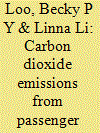

|
|
|
|
|
| Publication |
2012.
|
| Summary/Abstract |
This paper traces the historical evolution and spatial disparity of CO2 emissions from passenger transport in China. The general trends of CO2 emissions from four passenger transport modes are estimated by both the distance-based and fuel-based methods. The results suggest that CO2 emissions from road transport represented the leading source of passenger transport CO2 emissions in China. Moreover, they have continued to grow rapidly. Air transport was the second largest contributor since 1998. Emissions from rail and water transport have remained relatively stable with lower emission intensity. At the provincial level, great regional disparity was noticeable, especially in road transport. Moreover, the decomposition analysis shows that income growth was the principal factor leading to the growth of passenger transport CO2 emissions in China for both the 1949-1979 and 1980-2009 periods. The second most important factor was increased transport intensity and modal shifts for the former and the latter period, respectively. The main factor contributed to emission reduction was the lower emission intensity supported by policies, although the effect was weak. In the future, more policies to encourage modal shifts toward sustainable transport modes and travel reduction should be encouraged.
|
|
|
|
|
|
|
|
|
|
|
|
|
|
|
|
| 10 |
ID:
128447
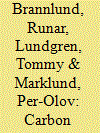

|
|
|
|
|
| Publication |
2014.
|
| Summary/Abstract |
We analyze carbon intensity performance at firm level and the effectiveness of the Swedish CO2 tax. Carbon intensity performance is derived from a production technology and measured as changes in the CO2 emission-output production ratio. As one of the first countries to introduce a CO2 tax in 1991, Sweden serves as an appropriate "test bench" for analyzing the effectiveness of climate policy in general. Firm level data from Swedish manufacturing spanning over the period 1990-2004 is used for the analysis. Results show that EP has improved in all the sectors and there is an evidence of decoupling of output production growth and CO2 emissions. Firms' carbon intensity performance responds both to changes in the CO2 tax and fossil fuel price, but is more sensitive to the tax.
|
|
|
|
|
|
|
|
|
|
|
|
|
|
|
|
| 11 |
ID:
150458
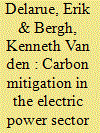

|
|
|
|
|
| Summary/Abstract |
In Europe, CO2 emissions from the electric power sector and energy intensive industries are capped under a cap-and-trade system (i.e., the EU ETS). When other indirect measures are taken to impact emissions in a specific sector under the cap (such as a push for renewables in the electric power sector), this has implications on the overall allowance price, and on CO2 emissions both from this specific sector and the other sectors under the cap. The central contribution of this paper is the derivation of impact curves, which describe these interactions, i.e., the impact on allowance price and the shift of emissions across sectors. From a set of detailed simulations of the electric power system operation, a so-called “emission plane” is obtained, from which impact curves can be derived. Focus is on interactions between CO2 abatement through fuel switching and measures affecting the residual electricity demand (such as deployment of renewables) in the electric power sector, as well as on interactions with other sectors, both in a short-term framework. A case study for Central-Western Europe is presented. The analysis reveals a substantial impact of renewables on CO2 emissions, and hence on emissions shifts across sectors and/or on the CO2 price.
|
|
|
|
|
|
|
|
|
|
|
|
|
|
|
|
| 12 |
ID:
125650
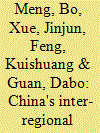

|
|
|
|
|
| Publication |
2013.
|
| Summary/Abstract |
In this study, we apply the inter-regional input-output model to explain the relationship between China's inter-regional spillover of CO2 emissions and domestic supply chains for 2002 and 2007. Based on this model, we propose alternative indicators such as the trade in CO2 emissions, CO2 emissions in trade and the regional trade balances of CO2 emissions. Our results do not only reveal the nature and significance of inter-regional environmental spillover within China's domestic regions but also demonstrate how CO2 emissions are created and distributed across regions via domestic and global production networks. Results show that a region's CO2 emissions depend on its intra-regional production technology, energy use efficiency, as well as its position and participation degree in domestic and global supply chains.
|
|
|
|
|
|
|
|
|
|
|
|
|
|
|
|
| 13 |
ID:
171514


|
|
|
|
|
| Summary/Abstract |
In order to explore the decoupling relationship and its influence factors between the growth of China's civil aviation sector and carbon emissions, as well as to forecast future CO2 emissions, the extended log-mean Divisia index model (LMDI), Tapio decoupling model and an emission prediction model were applied in this study. The results show the following. (1) Total carbon emissions fluctuate on an overall upward trend, but the level of oil consumption per revenue tonne-kilometers (RTK) shows a steady downward trend. (2) Among the four main factors, the “transportation amount growth” factor contributed most to CO2 emissions increases; followed by transport structure adjustment effects and alternative fuel effects. The “energy consumption intensity” factor plays a major role in inhibiting CO2 emissions. (3) The decoupling state of civil aviation predominantly stayed in a weak decoupling prior to 1988, expansive coupling and expansive negative decoupling during 1988–2000, and expansive coupling post-2000, which implies that the government should take comprehensive measures to reduce CO2 emissions. (4) Based on eight scenarios, China's civil aviation sector is predicted to be responsible for 0.13 Gt of CO2 emissions by 2020. Between 2020 and 2050, CO2 emissions may increase by a factor 1.6 to 3.9.
|
|
|
|
|
|
|
|
|
|
|
|
|
|
|
|
| 14 |
ID:
181793
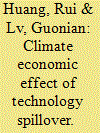

|
|
|
|
|
| Summary/Abstract |
There is increasing interest in the global CO2 emissions transfer caused by international trade. However, the reduction potential of technology spillover is rarely considered. More importantly, the effect of technology spillover on climate change and the social cost of carbon (SCC) should be further investigated to inform climate policy-makers. In this study, we investigate the climate economic impact of technology spillover through unidirectional coupling of the emissions embodied in bilateral trade (EEBT) method and the dynamic integrated model of climate and economy (DICE). The results indicate that technological progress in the electricity sector could contribute to climate change mitigation and SCC lowering. The trade-related CO2 emissions of key CO2 exporters could be substantially reduced, such as China, India, Russia, and resource- and labor-intensive countries. High-tech countries outsourced large amounts of CO2 emissions to labor- and resource-intensive countries. However, a large income gap remains between high-tech and labor/resource-intensive countries. These results indicate the great importance of technological progress and sustainable management throughout the global supply chain.
|
|
|
|
|
|
|
|
|
|
|
|
|
|
|
|
| 15 |
ID:
169894
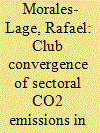

|
|
|
|
|
| Summary/Abstract |
An understanding of the evolution of sectoral CO2 emissions for all EU countries in recent decades would clearly be useful for political authorities when designing future environmental policies. This paper investigates the process of convergence in sectoral per capita CO2 emissions, with a focus on the energy sector. The concept of club convergence is used to analyse emissions in 28 EU countries from 1971 to 2012, with special attention paid to the energy subsectors (power generation and heating, manufactures and construction, transportation, and other minor fuel combustion). We find that core European countries (France, the Netherlands, Germany and the UK) are included in the best performing clubs, no matter the sector or subsector, whereas among Central and Eastern European Countries, a few diverge from the average towards higher emissions. Relative convergence among a large number of EU members would, therefore, support the relevance of both the EU abatement policy and international agreements in this process.
|
|
|
|
|
|
|
|
|
|
|
|
|
|
|
|
| 16 |
ID:
104983
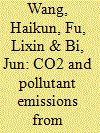

|
|
|
|
|
| Publication |
2011.
|
| Summary/Abstract |
In this paper, CO2 and pollutant emissions of PCs in China from 2000 to 2005 were calculated based on a literature review and measured data. The future trends of PC emissions were also projected under three scenarios to explore the reduction potential of possible policy measures. Estimated baseline emissions of CO, HC, NOx, PM10 and CO2 were respectively 3.16×106, 5.14×105, 3.56×105, 0.83×104 and 9.14×107 tons for China's PCs in 2005 with an uneven distribution among provinces. Under a no improvement (NI) scenario, PC emissions of CO, HC, NOx, PM10 and CO2 in 2020 are respectively estimated to be 4.5, 2.5, 2.5, 7.9 and 8.0 times that of 2005. However, emissions other than CO2 from PCs are estimated to decrease nearly 70% by 2020 compared to NI scenario mainly due to technological improvement linked to the vehicle emissions standards under a recent policy (RP) scenario. Fuel economy (FE) enhancement and the penetration of advanced propulsion/fuel systems could be co-benefit measures to control CO2 and pollutant emissions for the mid and long terms. Significant variations were found in PC emission inventories between different studies primarily due to uncertainties in activity levels and/or emission factors (EF).
|
|
|
|
|
|
|
|
|
|
|
|
|
|
|
|
| 17 |
ID:
192740
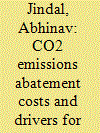

|
|
|
|
|
| Summary/Abstract |
Indian power industry contributes nearly half of its overall CO2 emissions. In this study, we answer three related questions. First, what is the abatement cost of CO2 emissions for the Indian thermal power industry under three different policy scenarios - business as usual, emissions reduction only, and simultaneous emissions reduction and energy efficiency enhancement. Second, what are the determinants of these abatement costs of CO2 emissions. Third, which abatement policy scenario is more beneficial. For this, we employ a plant level dataset covering 93% of installed capacity and use a parametric quadratic directional output distance function to estimate marginal abatement costs by applying deterministic linear programming methods. Our findings are: First, the abatement costs range between US$ 46.43–71.11 per ton CO2, depending on the policy scenario chosen. Second, plant age, location, size, ownership, and CO2 intensity are all significant drivers of abatement costs. Third, while greater emissions reductions are possible under the emissions reduction only scenario vis-à-vis simultaneous emissions reduction and energy efficiency enhancement scenario, both scenarios are compatible with meeting the Paris agreement goals. This paper helps decision makers to allocate CO2 abatement targets to plants in line with their abatement costs and potential.
|
|
|
|
|
|
|
|
|
|
|
|
|
|
|
|
| 18 |
ID:
125648
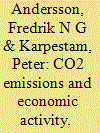

|
|
|
|
|
| Publication |
2013.
|
| Summary/Abstract |
We analyze the short-term and the long-term determinants of energy intensity, carbon intensity and scale effects for eight developed economies and two emerging economies from 1973 to 2007. Our results show that there is a difference between the short-term and the long-term results and that climate policy are more likely to affect emission over the long-term than over the short-term. Climate policies should therefore be aimed at a time horizon of at least 8 years and year-on-year changes in emissions contains little information about the trend path of emissions. In the long-run capital accumulation is the main driver of emissions. Productivity growth reduces the energy intensity while the real oil price reduces both the energy intensity and the carbon intensity. The real oil price effect suggests that a global carbon tax is an important policy tool to reduce emissions, but our results also suggest that a carbon tax is likely to be insufficient decouple emission from economic growth. Such a decoupling is likely to require a structural transformation of the economy. The key policy challenge is thus to build new economic structures where investments in green technologies are more profitable.
|
|
|
|
|
|
|
|
|
|
|
|
|
|
|
|
| 19 |
ID:
111439
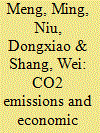

|
|
|
|
|
| Publication |
2012.
|
| Summary/Abstract |
For the period of the 12th Five-Year Plan (2011-2015), the Chinese government has decided to reconsider and adjust its policies on economic development because of the pressures of CO2 emissions and fossil energy consumption. The current paper adopts the logarithmic Stochastic Impacts by Regression on Population, Affluence, and Technology (STIRPAT) model to simulate the relationship between CO2 emissions and other economic development factors in China. Three groups of outliers are found using samples from 1989 to 2008 and the Partial Least Square (PLS) regularity test method. The outlier analysis reveals three important areas for CO2 reduction: (a) decreasing the share of coal to the total energy consumption and replacing it with non-fossil energies; (b) controlling vehicles used in the cities as well as (c) adjusting industrial structure. Furthermore, based on the social and economic realities of China, the current paper designs six feasible development scenarios for the period covered by the 12th Five-Year Plan and predicts the values of each factor in each scenario. The values can test the implementation of China's CO2 control development concept. The experiences obtained by outlier analysis can be of significant reference value for realizing the predicted scenarios.
|
|
|
|
|
|
|
|
|
|
|
|
|
|
|
|
| 20 |
ID:
150824
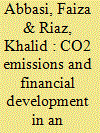

|
|
|
|
|
| Summary/Abstract |
This paper explores the influence of economic and financial development on carbon emissions in a small emerging economy. The study employs ARDL approach to investigate the long run relationship between carbon emissions and a set of economic and financial variables, an Error Correction Model (ECM) to capture the short run dynamics, Granger causality in an augmented VAR framework to check the causality direction, and variance decomposition based on an estimated Vector Error Correction Model (VECM) to determine the relative contributions of economic and financial variables to the evolution of per capita carbon emissions. The periods considered were the full sample (1971–2011), and a reduced sample sub-period (1988–2011) that corresponded to greater liberalization and financial sector development. The financial variables played a role in emission mitigation only in the latter period where greater degree of liberalization and financial sector development occurred. Even then the relative magnitude of emissions mitigation attributable to financial variables was much smaller compared to the emissions raising impact of rising per capita incomes. This underscores the need for adopting other mitigation policies for reducing carbon footprints in those emerging economies where a sufficient degree of financial deepening and financial sector development has not yet taken place.
|
|
|
|
|
|
|
|
|
|
|
|
|
|
|
|
|
|
|
|
|